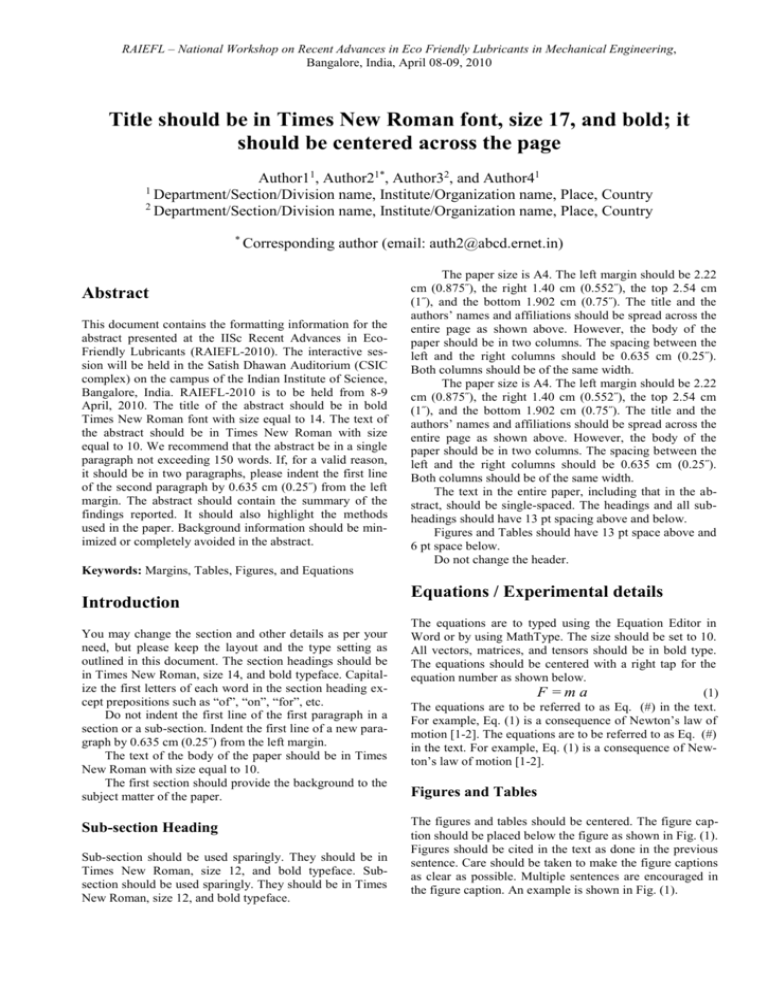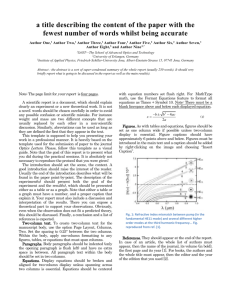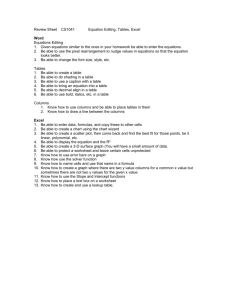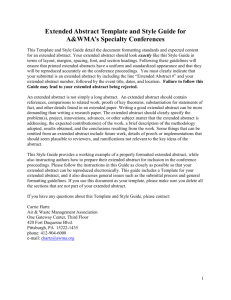here - Department of Mechanical Engineering
advertisement

RAIEFL – National Workshop on Recent Advances in Eco Friendly Lubricants in Mechanical Engineering, Bangalore, India, April 08-09, 2010 Title should be in Times New Roman font, size 17, and bold; it should be centered across the page Author11, Author21*, Author32, and Author41 1 Department/Section/Division name, Institute/Organization name, Place, Country 2 Department/Section/Division name, Institute/Organization name, Place, Country * Corresponding author (email: auth2@abcd.ernet.in) Abstract This document contains the formatting information for the abstract presented at the IISc Recent Advances in EcoFriendly Lubricants (RAIEFL-2010). The interactive session will be held in the Satish Dhawan Auditorium (CSIC complex) on the campus of the Indian Institute of Science, Bangalore, India. RAIEFL-2010 is to be held from 8-9 April, 2010. The title of the abstract should be in bold Times New Roman font with size equal to 14. The text of the abstract should be in Times New Roman with size equal to 10. We recommend that the abstract be in a single paragraph not exceeding 150 words. If, for a valid reason, it should be in two paragraphs, please indent the first line of the second paragraph by 0.635 cm (0.25˝) from the left margin. The abstract should contain the summary of the findings reported. It should also highlight the methods used in the paper. Background information should be minimized or completely avoided in the abstract. The paper size is A4. The left margin should be 2.22 cm (0.875˝), the right 1.40 cm (0.552˝), the top 2.54 cm (1˝), and the bottom 1.902 cm (0.75˝). The title and the authors’ names and affiliations should be spread across the entire page as shown above. However, the body of the paper should be in two columns. The spacing between the left and the right columns should be 0.635 cm (0.25˝). Both columns should be of the same width. The paper size is A4. The left margin should be 2.22 cm (0.875˝), the right 1.40 cm (0.552˝), the top 2.54 cm (1˝), and the bottom 1.902 cm (0.75˝). The title and the authors’ names and affiliations should be spread across the entire page as shown above. However, the body of the paper should be in two columns. The spacing between the left and the right columns should be 0.635 cm (0.25˝). Both columns should be of the same width. The text in the entire paper, including that in the abstract, should be single-spaced. The headings and all subheadings should have 13 pt spacing above and below. Figures and Tables should have 13 pt space above and 6 pt space below. Do not change the header. Keywords: Margins, Tables, Figures, and Equations Introduction You may change the section and other details as per your need, but please keep the layout and the type setting as outlined in this document. The section headings should be in Times New Roman, size 14, and bold typeface. Capitalize the first letters of each word in the section heading except prepositions such as “of”, “on”, “for”, etc. Do not indent the first line of the first paragraph in a section or a sub-section. Indent the first line of a new paragraph by 0.635 cm (0.25˝) from the left margin. The text of the body of the paper should be in Times New Roman with size equal to 10. The first section should provide the background to the subject matter of the paper. Sub-section Heading Sub-section should be used sparingly. They should be in Times New Roman, size 12, and bold typeface. Subsection should be used sparingly. They should be in Times New Roman, size 12, and bold typeface. Equations / Experimental details The equations are to typed using the Equation Editor in Word or by using MathType. The size should be set to 10. All vectors, matrices, and tensors should be in bold type. The equations should be centered with a right tap for the equation number as shown below. (1) F =ma The equations are to be referred to as Eq. (#) in the text. For example, Eq. (1) is a consequence of Newton’s law of motion [1-2]. The equations are to be referred to as Eq. (#) in the text. For example, Eq. (1) is a consequence of Newton’s law of motion [1-2]. Figures and Tables The figures and tables should be centered. The figure caption should be placed below the figure as shown in Fig. (1). Figures should be cited in the text as done in the previous sentence. Care should be taken to make the figure captions as clear as possible. Multiple sentences are encouraged in the figure caption. An example is shown in Fig. (1). RAIEFL – National Workshop on Recent Advances in Eco Friendly Lubricants in Mechanical Engineering, Bangalore, India, April 08-09, 2010 ing conference proceedings of high quality. The formatting rules for the RAIEFL-2010 abstracts are outlined in this document. You may change the section names and other details as per your need, but please keep the layout and the type setting as outlined in this document. The cooperation of all the authors is appreciated in producing conference proceedings of high quality. Acknowledgment Keep the acknowledgment short and sweet. References Figure 1: Results obtained from the experiments conducted. Shown above are the normalized parameters. Tables are to be formatted as shown in Table 1. Table captions should be placed at the top. Tables should be cited in the text as shown in the first sentence of this paragraph. Tables are to be formatted as shown in Table 1. Table captions should be placed at the top. Tables should be cited in the text as shown in the first sentence of this paragraph. Table 1: Some parameters and their ranges used in the experiment S. No. Parameters Range 1 x 0≤x≤10 2 y 0≤y≤10 3 z 0≤z≤10 Results and discussion In this section, we discuss the formatting of references. References should be numbered in the order of their first occurrence. They should be cited with “[#]” at the end of the sentence or in the middle as the case may be. The citations should be listed at the end of the paper. The format of the citations is given in the section entitled “References” at the end of the paper. References should be numbered in the order of their first occurrence. They should be cited with “[#]” at the end of the sentence or in the middle as the case may be. The citations should be listed at the end of the paper. The format of the citations is given in the section entitled “References” at the end of the paper. Conclusions The formatting rules for the RAIEFL-2010 abstracts are outlined in this document. You may change the section names and other details as per your need, but please keep the layout and the type setting as outlined in this document. The cooperation of all the authors is appreciated in produc- [1] S. Finger and J.R. Dixon, “A review of research in mechanical engineering design. Part II,” Research in Engineering Design, Vol. 1, No. 2, June 1989, pp. 121-137. [2] I.H. Shames, Engineering Mechanics: Statics and Dynamics, Prentice Hall, 4 sub edition, August 1996.








